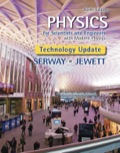
Concept explainers
The number of photons per second escaping the opening and having wavelengths between
Answer to Problem 11P
The number of photons per second escaping the opening and having wavelengths between
Explanation of Solution
The wavelength range is between
Write the Plank’s
Here,
Write the equation for
Here,
Put equation (II) in equation (I).
The energy per time leaving the hole can be determined by taking the product of the intensity per wavelength, area and the wavelength range.
Write the equation for the energy per time leaving the hole.
Here,
Write the equation for the area of the hole.
Here,
Put equations (III) and (V) in equation (IV).
Write the equation for the average photon energy.
Here,
Write the equation for
Put equation (II) in the above equation.
Put the above equation in equation (VII).
Write the equation for the number of photons per second escaping the opening.
Here,
Put equations (VI) and (VIII) in the above equation.
Conclusion:
It is given that the temperature of the blackbody is
Substitute ,
Therefore, the number of photons per second escaping the opening and having wavelengths between
Want to see more full solutions like this?
Chapter 40 Solutions
Physics for Scientists and Engineers with Modern Physics Technology Update
- If the wavelength of an electron is 5.00 x 10-7 m, how fast is it moving? (b) If the electron has a speed equal to 1.00 x 107 m/s, what is its wavelength?arrow_forwardWhat is the de Broglie wavelength for an electron with speed (a) v = 0.480c and (b) v = 0.960c?arrow_forwardWhat is the wavelength of (a) a 12-keV X-ray photon; (b) a 2.O-MeV y -ray photon?arrow_forward
- How fast must an electron move to have a kinetic energy equal to the photon energy of sodium light at wavelength 590 nm?arrow_forwardA 100-Watt tungsten filament lamp operates at a temperature of 2198 K. Assuming that the filament emits like a black body, determine the wavelength (in nm) of the maximum irradiancearrow_forwardA satellite in Earth orbit maintains a panel of solar cells of area 2.60 m2 perpendicular to the direction of the Sun’s light rays. The intensity of the light at the panel is 1.39 kW/m2. (a) At what rate does solar energy arrive at the panel? (b) At what rate are solar photons absorbed by the panel? Assume that the solar radiation is monochromatic, with a wavelength of 550 nm, and that all the solar radiation striking the panel is absorbed. (c) How long would it take for a “mole of photons” to be absorbed by the panel?arrow_forward
- On its high power setting, a microwave oven produces 900 W of 2560 MHz microwaves. (a) How many photons per second is this? (b) How many photons are required to increase the temperature of a 0.500-kg mass of pasta by 45.0ºC , assuming a specific heat of 0.900 kcal/kg ⋅ ºC ? Neglect all other heat transfer. (c) How long must the microwave operator wait for their pasta to be ready?arrow_forwardWhat is the ratio between the thermal radiation of an object at 60 oC compared to the same object at 20 oC?arrow_forwardConsider a photon with wavelength 0.011 nm. l = 0.011 nm What is the momentum of the photon in kg m/s? What is its energy in MeV?arrow_forward
- What is the de Broglie wavelength of(a) a bullet of mass 0.040 kg travelling at the speed of 1.0 km/s,(b) a ball of mass 0.060 kg moving at a speed of 1.0 m/s, and(c) a dust particle of mass 1.0 × 10-9 kg drifting with a speed of 2.2 m/s?arrow_forwardRadiation has been detected from space that is characteristic of an ideal radiator at T = 2.728 K. (This radiation is a relic of the Big Bang at the beginning of the universe.) For this temperature, at what wavelength does the Planck distribution peak? In what part of the electromagnetic spectrum is this wavelength?arrow_forwardFor the thermal radiation from an ideal blackbody radiator with a surface temperature of 2000 K, let Ic represent the intensity per unit wavelength according to the classical expression for the spectral radiancy and IP represent the corresponding intensity per unit wavelength according to the Planck expression.What is the ratio Ic/IP for a wavelength of (a) 400 nm (at the blue end of the visible spectrum) and (b) 200 mm (in the far infrared)? (c) Does the classical expression agree with the Planck expression in the shorter wavelength range or the longer wavelength range?arrow_forward
 Modern PhysicsPhysicsISBN:9781111794378Author:Raymond A. Serway, Clement J. Moses, Curt A. MoyerPublisher:Cengage Learning
Modern PhysicsPhysicsISBN:9781111794378Author:Raymond A. Serway, Clement J. Moses, Curt A. MoyerPublisher:Cengage Learning Principles of Physics: A Calculus-Based TextPhysicsISBN:9781133104261Author:Raymond A. Serway, John W. JewettPublisher:Cengage Learning
Principles of Physics: A Calculus-Based TextPhysicsISBN:9781133104261Author:Raymond A. Serway, John W. JewettPublisher:Cengage Learning Glencoe Physics: Principles and Problems, Student...PhysicsISBN:9780078807213Author:Paul W. ZitzewitzPublisher:Glencoe/McGraw-Hill
Glencoe Physics: Principles and Problems, Student...PhysicsISBN:9780078807213Author:Paul W. ZitzewitzPublisher:Glencoe/McGraw-Hill Physics for Scientists and Engineers: Foundations...PhysicsISBN:9781133939146Author:Katz, Debora M.Publisher:Cengage Learning
Physics for Scientists and Engineers: Foundations...PhysicsISBN:9781133939146Author:Katz, Debora M.Publisher:Cengage Learning Physics for Scientists and Engineers with Modern ...PhysicsISBN:9781337553292Author:Raymond A. Serway, John W. JewettPublisher:Cengage Learning
Physics for Scientists and Engineers with Modern ...PhysicsISBN:9781337553292Author:Raymond A. Serway, John W. JewettPublisher:Cengage Learning University Physics Volume 3PhysicsISBN:9781938168185Author:William Moebs, Jeff SannyPublisher:OpenStax
University Physics Volume 3PhysicsISBN:9781938168185Author:William Moebs, Jeff SannyPublisher:OpenStax





